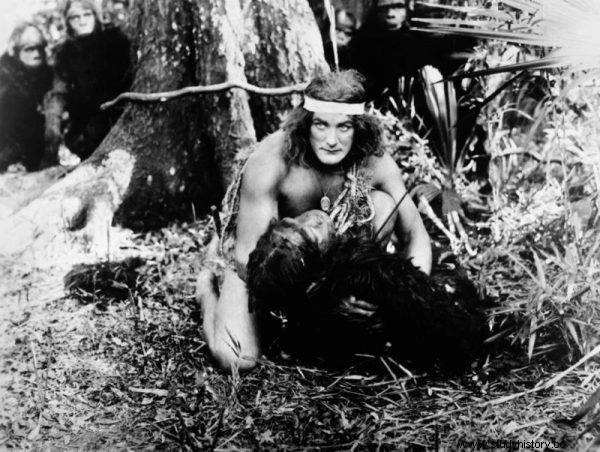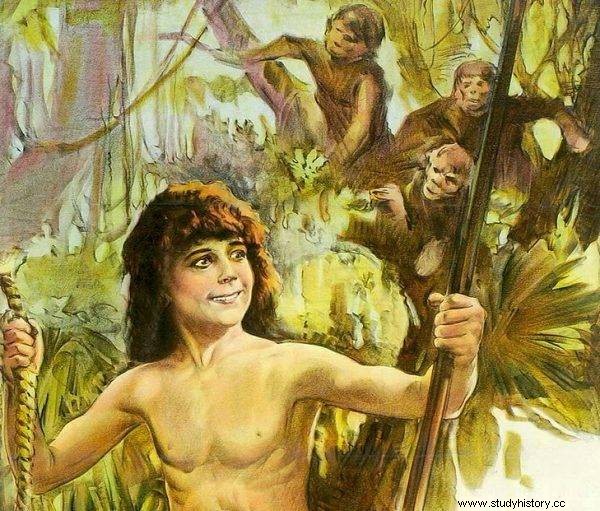In 1912, thanks to the writer Edgar Rice Burroughs, the world learned about Tarzan - the son of British aristocrats raised in a herd of monkeys. He moved and jumped among the trees, he was extremely agile and strong. At last he discovered his humanity, found love and returned to England. Tarzan is a fictional character, but history knows many cases of people growing up among animals. Unfortunately, it rarely ended happily ...
The figure of Lord Greystoke, an English aristocrat who lost his parents in infancy and was adopted by monkeys, reflected the spirit of the late nineteenth and early twentieth centuries. It consisted of colonialism, exploration of lands outside Europe, including Africa, and in the scientific sphere - belief in evolution - the biological and socio-cultural one.
Cultural anthropologists of the time believed that humanity, also in the area of social organization, is developing from simpler to more advanced forms, and that the cradle of the first link of evolution should be sought in our animal kin . After all, as Charles Darwin preached, mankind evolved from a monkey.

The real "Tarzani", so far found in the jungle, were not children of rich parents from Europe, but black orphans. Their stories are not a metaphor for evolution. Rather, they tell about human tragedies ... (illustrative illustration)
So Tarzan was, in a way, a symbolic, most primal, animal man, an archetype of the then image of human development. At the same time, in order to show that the atavisms inherent in us are still there, the author made an ape-man out of an English lord, and therefore an extremely cultured, distinguished and wealthy person.
Today, in cultural anthropology, evolutionism is considered to be a long refuted, archaic trend, and in addition it is seen as a propaganda justification for domination and use for the sake of progress in poor communities from the colonies by the wealthy countries of the West.
However, at the time of Tarzan's release, the "King of the Apes" series of books was extremely successful. Followers and comics appeared. Hollywood has also reached for the character of Tarzan. In fact, these real "Tarzani", so far found in the jungle, were not children of rich European parents, but black orphans. Their stories are not a metaphor for evolution. Rather, they are about human tragedies…
Raised by monkeys
The most famous so-called the wild child is John Ssabunnya. Probably as a two-year-old he escaped deep into the jungles of Uganda to save his life, after seeing the death of his mother murdered by his father with his own eyes.
A tiny child wandered exhausted and hungry in the forest when it encountered Chlorocebus pygerythrus monkeys (the so-called vervet monkey). According to the boy's later accounts, the monkeys provided him with their food - sweet potatoes, cassava, bananas. After his hunger was satisfied, he followed the herd of animals and was finally accepted and adopted by them.

However, at the time of Tarzan's release, the "King of the Apes" series of books was extremely successful. Followers and comics appeared. Hollywood has also reached for Tarzan.
By observing the monkeys every day, John began to learn their movements, communication and behavior. He learned gestures, sounds, climbing trees. His lifestyle and diet were the same as his animal caretakers. He ate on nuts, fruit, and corn. He spent three years with the monkeys.
One day in 1991, an inhabitant of one of the nearby villages noticed a man on the river bank, crouching next to the current, rinsing the collected fruit in it. The stranger did it exactly like monkeys. The woman returned to the village and told about everything. Farmers surrounded the animals. The monkeys with the boy climbed trees and screamed, throwing branches and excrement, tried to chase people away. In the end, however, the terrified little boy was lowered to the ground.
Back to the human world
The child could not speak or move upright. Due to copying the way the monkeys moved, their feet and hands were deformed and injured. It made sounds identical to the sounds of animals. She was extremely skinny and dehydrated. He had bruises all over his body.
After being brought to a Christian orphanage in Kamuzinda, about 160 kilometers from Kampala, the capital of Uganda, the boy ate warm soup. As a result, he got fever and diarrhea. While defecating, he released a 50cm tapeworm.

Tarzan is a fictional character, but history knows many cases of people growing up among animals. Unfortunately, it rarely ended with a happy end…
John was adopted by the owners of the orphanage - Paul and Molly Wassawa. From then on began to learn the simplest of human habits - from sleeping in bed, to getting dressed, to eating from a plate . Eventually it was possible to bring him back to the world, although he remained a bit intellectually retarded.
John is a grown man today. When he learned to speak, it turned out that he has a beautiful, melodious voice. His talent for singing even took him to the British Isles. He performed there with the choir of the Wassawa orphanage. He also showed sports talents. In 2003, he performed at the Special Olympics in Dublin as captain of the national soccer team. He also took part in competitions in the United States, from where he brought back two medals.
Upbringing or a survival strategy?
Well-documented cases of wild children are a mine of knowledge for scientists in the question of the age-old "dispute" over the structure and psychophysical development of man. They hope to find an answer to the question about the primacy of genes or upbringing and environment.
No wonder John's story has been researched many times. Did the little monkeys actually take care of the boy wandering in the jungle and he was recognized as a full member of the herd, or was the truth different? Documentary Interview with John by Dr. Duglas Candland, an American psychologist at Bucknell University in Pennsylvania, showed that the reality is more complicated.

Well-documented cases of wild children are a mine of knowledge for scientists
The scientist confirmed Ssabunny's story of being raised by animals. In the atlas of monkeys John immediately found and pointed out those with whom he lived in the jungle. Candland, however, also found significant nuances in his stories that make her perceive her in a slightly different light.
17-year-old John admitted that did not participate in the "customs" of the herd, such as grooming each other, "combing", pulling insects, scratching the hair, stroking etc. These are the elements of behavior that constitute a specific "language" of monkeys, which also allows for establishing a hierarchy in the herd. Meanwhile, Ssabunnya was only an observer of such "rituals" and not a participant in them. This would indicate that the monkeys tolerated his presence, but still - as a human - he was out of the herd.
Ultimately, the scientist decided that the child was not raised by animals, but grew up alongside them, as it were, following the herd and feeding on what had accumulated. So it was a peculiar, though unconscious, human strategy of survival in extremely unfavorable circumstances.
Another study - a CT scan - found that John had damaged areas of the brain responsible for speech. In early childhood, he was hit hard on the head . Does it have to do with the hell of a family life he experienced and a crime he saw with his own eyes that pushed him into the wilderness? It is very likely.
Wild children
The story of John Ssabunny is one of the best-studied cases of human life with animals. There are many more so-called wild children, living not only in monkeys, but also in various herds of other species.
Robert Mayanja (1982) lost his parents in the Ugandan Civil War. He was three years old when President Milton Obote's troops raided a rebel village 80 kilometers outside Kampala. The orphaned child fled into the jungle. Until the age of six, he lived with monkeys.
Saturday Mithane was 5 years old when he was taken out of his "natural" surroundings, which he knew, the herds of monkeys. His parents abandoned him. A boy from the Kwazulu Province in South Africa was spotted when he and his fellow countrymen "raided" the farmlands of local farmers. Then people grabbed him. He was named Saturday by the manager of an orphanage for intellectually retarded children. The name lends him her own.
Saturday was not found in the human world. He was aggressive towards the other children, refused to play, had trouble adapting to the human way of moving. He was jumping on furniture and bananas remained his favorite food.
Could he move away from animal behavior over time? We won't find out. In 2005, a fire broke out in an orphanage in South Africa. Little Saturday and a few other children were killed in flames.

Contrary to the literary fiction of the Tarzan books, these stories very rarely end with a full recovery to physical and intellectual fitness.
Dog-girl
In the 1980s, a Ukrainian, Oksana Malaya, grew up in the countryside of the Kherson Oblast in the central part of the country. Instead of living in the house of her parents, who were drinking to death, lived with Russian Black Terriers for 6 years . During one of the alcoholic libations, her guardians hid in the dog kennel and stayed there. She was warm, she felt safe.
Oksana's parents did not even notice the disappearance of the child in a drunken sight. The girl was found at the age of 8. She walked on all fours, barked, rubbed herself, acted like a dog. Eventually, after years of advanced behavioral therapy, it was successfully returned to the human world. She learned to speak fluently and in her adult life she found a job on a farm. However, it remained somewhat lagging behind in intellectual development.
There are many such accounts of wild children. They have several common points. Contrary to the literary fiction of the Tarzan books, these stories rarely end with a full recovery to physical and intellectual fitness. At the same time, it is difficult to say unequivocally to what extent the life in the herd is "responsible" for the disability of these people, and to what extent the extremely traumatic stories that happened before.
Often times, what pushed wild children out of the human world was far more terrifying than the "animal" experiences. More than once, people were behind it who should have provided warmth and care for the little ones. As a last resort, they behaved "human", because animals unnecessarily do not kill, abuse or abandon.
